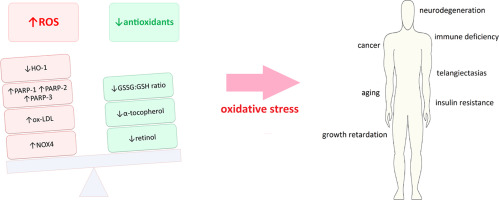Elsevier, Redox Biology, Volume 11, 1 April 2017
Rare pleiotropic genetic disorders, Ataxia-telangiectasia (A-T), Bloom syndrome (BS) and Nijmegen breakage syndrome (NBS) are characterised by immunodeficiency, extreme radiosensitivity, higher cancer susceptibility, premature aging, neurodegeneration and insulin resistance. Some of these functional abnormalities can be explained by aberrant DNA damage response and chromosomal instability. It has been suggested that one possible common denominator of these conditions could be chronic oxidative stress caused by endogenous ROS overproduction and impairment of mitochondrial homeostasis.
Elsevier, Environmental Development, Volume 21, 1 March 2017
Assuming communities in a city may formally express their aspirations for the future sustainability of their city, which technological innovations for changing the city's infrastructure and metabolism might they introduce today, as a first step towards realizing their distant aspirations? What is more, recognizing the diversity of aspirations that may never be reconciled into a consensus, might some innovations and policy interventions be nevertheless more privileged than others, in being non-foreclosing? How might we discover this?
Elsevier, Journal of Cleaner Production, Volume 145, 1 March 2017
The process of decision making can be critical in various ways. In particular, because it determines the path towards or away from sustainable development. In this context, the present study examined the relationship between rationalities for decisions making processes and sustainable development in order to gain a better understanding of how to promote a more sustainable development model.
Elsevier, Renewable and Sustainable Energy Reviews, Volume 69, 1 March 2017
In the current era of sustainable development, energy planning has become complex due to the involvement of multiple benchmarks like technical, social, economic and environmental. This in turn puts major constraints for decision makers to optimize energy alternatives independently and discretely especially in case of rural communities. In addition, topographical limitations concerning renewable energy systems which are mostly distributed in nature, the energy planning becomes more complicated.
Elsevier, Building and Environment, Volume 114, 1 March 2017
Thirty years of public health research have demonstrated that improved indoor environmental quality is associated with better health outcomes. Recent research has demonstrated an impact of the indoor environment on cognitive function. We recruited 109 participants from 10 high-performing buildings (i.e. buildings surpassing the ASHRAE Standard 62.1–2010 ventilation requirement and with low total volatile organic compound concentrations) in five U.S. cities. In each city, buildings were matched by week of assessment, tenant, type of worker and work functions.
Elsevier, The Lancet Gastroenterology and Hepatology, Volume 2, 1 March 2017
Background The 69th World Health Assembly approved the Global Health Sector Strategy to eliminate hepatitis C virus (HCV) infection by 2030, which can become a reality with the recent launch of direct acting antiviral therapies. Reliable disease burden estimates are required for national strategies. This analysis estimates the global prevalence of viraemic HCV at the end of 2015, an update of—and expansion on—the 2014 analysis, which reported 80 million (95% CI 64–103) viraemic infections in 2013.
Elsevier, Materials Today, Volume 20, March 2017
The existing methods for recycling electronic wastes such as the printed circuit boards (PCB), which contains a large number of components and elements, face significant challenges when considering environmentally benign and easily separable disposal targets. We report here a low-temperature ball milling method that breaks down PCBs all the way into nanoscale particles which further enables enhanced separation of its different base constituent materials that are the polymer, oxide, and metal.
Elsevier, Sustainable Computing: Informatics and Systems, Volume 13, 1 March 2017
Most conventional scheduling problems use production efficiency, cost and quality as their preeminent optimization objectives. However, because of increasing costs of energy and environmental pollution, “low-carbon scheduling” as a novel scheduling model has received increasing attention from scholars and engineers. This scheduling model focuses on reducing energy consumption and environmental pollution at the workshop level.
Elsevier, Trends in Microbiology, Volume 25, 1 March 2017
The past decade has witnessed a burst of study regarding antibiotic resistance in the environment, mainly in areas under anthropogenic influence. Therefore, impacts of the contaminant resistome, that is, those related to human activities, are now recognized. However, a key issue refers to the risk of transmission of resistance to humans, for which a quantitative model is urgently needed. This opinion paper makes an overview of some risk-determinant variables and raises questions regarding research needs.
Elsevier,
The Lancet HIV, Volume 4, 1 March 2017
Background Sex workers are disproportionately affected by HIV compared with the general population. Most studies of HIV risk among sex workers have focused on individual-level risk factors, with few studies assessing potential structural determinants of HIV risk. In this Article, we examine whether criminal laws around sex work are associated with HIV prevalence among female sex workers.

